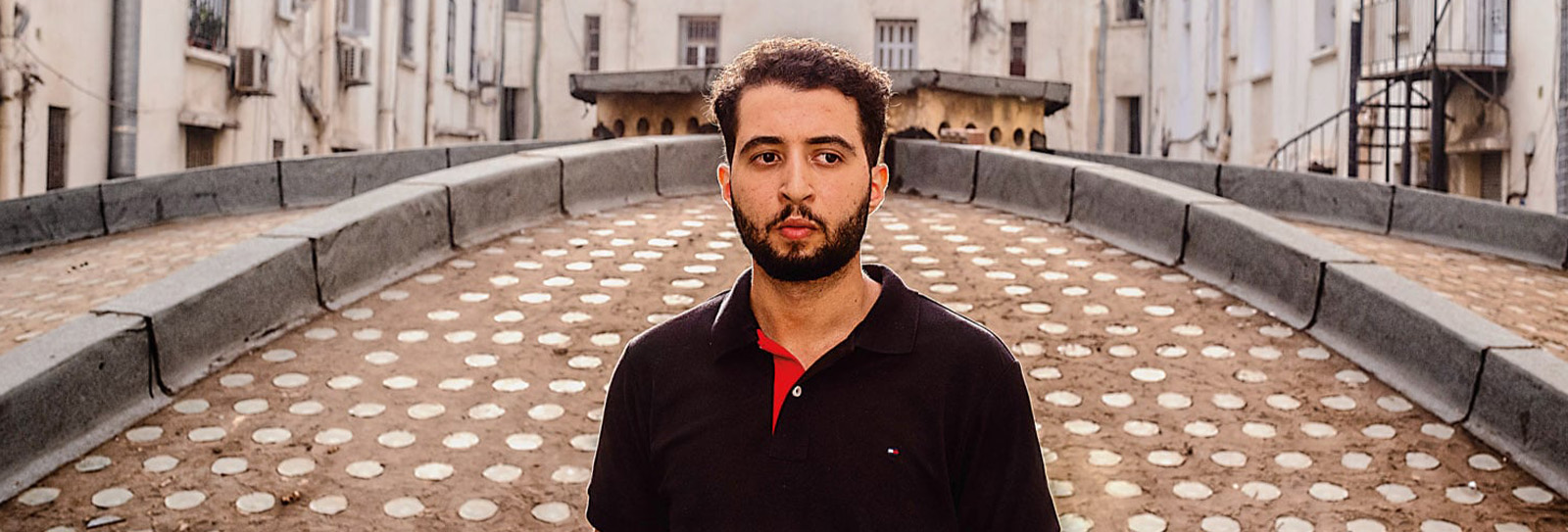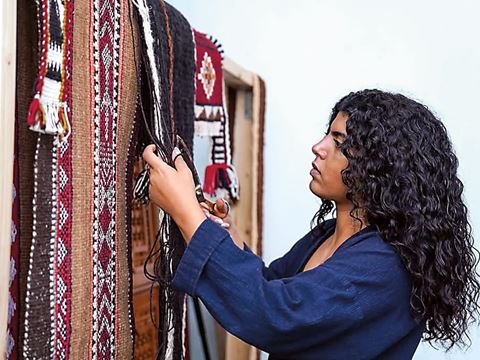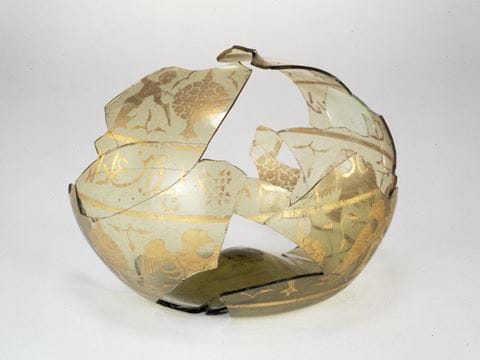
Casablanca Art and Architecture Merge for Native Son Alaa Halifi
Working with civic reality as an architect and personal imagination as a novelist, Alaa Halifi has, at age 23, already won awards in both fields. His subject: his city, Casablanca.


Romanticized by Hollywood and toyed with by European architects, Casablanca sprawls along the sea and gnaws steadily at its outskirts, much as other modern metro areas where growth seems to have all happened pretty much in the last century. Known colloquially by both Arabic speakers and others simply as “Casa,” it is a conglomeration of chaos and contradictions, heritage and kitsch; brutal and beautiful, unsettling and inviting, ephemeral and enduring. It is a merge lane for past, present and future that leads to a collision of Moroccan artisanship and European modernism.
It’s also a city where 23-year-old author and architect Alaa Halifi walks the streets with the affectionate yet critical eye of a native son.
He set his first book, a novel titled Madeeh al-junoon (In praise of madness), on these streets to “reflect the complex reality of my city” and “shed light on the marginalized and chaotic part of the city’s underworld,” putting to paper what he and his generation see. The resulting story fuses reality and fantasy and offers a vision for the city as it is as well as what it could be.
It earned him the 2021 al-Rafidain First Book Prize. Launched in 2019 by the Lebanon-based al-Rafidain Foundation, the prize recognizes young, newly published authors from across the Arabic-speaking world. Out of 200 submissions, Halifi’s was distinguished, the judges wrote, by its “deep dive into the worlds of Casablanca.”
Halifi brings this same award-winning energy to his design for restoring disused city buses as mobile health clinics. He has also designed a network of green spaces in a city where these are at a premium. His hope is that his work can speak for a generation of Casawi, or Casablanca locals, who he explains have been left out of too many discussions of the city and its future.
“Without art or concrete forms of expression, we will be forgotten. Instagram posts and TikTok videos aren’t enough,” he says. “So I write, design and dream of a world that could be, in the midst of the one that is.”

From Port to Metropolis
Casablanca was established in the seventh century CE by Zenata Berbers who named it Anfa. It rose to prominence as a thriving port and trade center under the Marinid Dynasty of the 13th to 15th century. Independent after the Marinid fall in 1465, Anfa became a safe harbor for privateers—pirates—whose anticolonialist predations led the Portuguese to raze the town by bombardment three years later. Several decades later, the Portuguese resurrected the port, built their own fortress and called the town Casa Bianca (White House). The name moved into Arabic as Dar al-Bayda under Sidi Mohammed ben Abdallah during his reconstruction of the city following its devastation by earthquake in 1755, and the Arabic name is still used on maps and official correspondence.
The Spanish inherited what they referred to as Casablanca—Whitehouse—via treaty in 1799. In 1907 the French, too, bombarded the city, and their occupation of Casablanca and Morocco brought the city into yet another era. Under French colonial rule, and through a combination of armed power, debt control and the co-opting of Morocco’s royal family, Casablanca became a booming commercial center. Between 1916 and 1927 alone, the population doubled. The port city transformed into an “ethnic and financial nerve center,” taking in people of various backgrounds, many seeking relief from repressions in Europe. Half Muslim, one-third European, and one-sixth Jewish, Casablanca’s “mosaic of populations” intermixed on social and urban levels, wrote architect Jean-Louis Cohen and sociologist Monique Eleb in their book, Casablanca: Colonial Myths and Architectural Ventures.
Other scholars such as a Patrick Calmon de Carvalho Braga and Driss Maghraoui commented that colonial Casablanca, a hub of rapid, if often unequal determination became known to European architects and city planners as a kind of living laboratory for the imposition of modernist urban design.
One “huge, buzzing construction site,” Cohen and Eleb wrote. The “sprouting city” featured Paris-style broad avenues and boulevards that connected sea, rail and industry with neighborhoods built for particular populations. Though rife with ethnic and class-based inequalities, its modern, sober, often grandiose lines married Moroccan, Berber and Islamic traditions and vernaculars with European modernism. From its terraces, balconies and porticoes, every view evinced a style with “the hand of the present firmly imprinted in the mould of the past,” wrote Cohen and Eleb.

A Real Casablanca?
Still today, everywhere you look, Halifi says, Casa’s fragile former glories are evident.
Walking through the al-Fida neighborhood in the Mers Sultan district, Halifi points out art-deco-inspired theaters that used to show films from Bollywood to Hollywood to kung fu, once famed, now shuttered.
Fading legacies like these inspired Halifi to embark on one of his first deep explorations into Casablanca’s history. Speaking to residents living on and around Avenue al-Fida, one of Casa’s oldest thoroughfares, he uncovered memories of revolution and revelry through archived documents and photographs from decades past. Halifi’s inspiration not only emerged out of a desire to rediscover the past but also to understand the streets he himself grew up on.
Halifi has always lived here, within a few blocks of Avenue al-Fida, in Derb Sultan, one of Casa’s most densely populated and historic districts. As a kid, he would often frequent al-Fida’s now-derelict theaters with his friends.
It was on Derb Sultan’s side roads and squares, what is to him “the real Casablanca,” that Halifi became the young man and celebrated creative he is today. Eating spicy tuna sandwiches at Place Sidi Maarouf, hanging with friends in the shade of a eucalyptus tree at the Hermitage Gardens or watching the traffic honk and swerve its way in front of the raw concrete of Assunna Mosque—designed in brutalist style by Jean-Francois Zevaco—Halifi got to know his city, story by story, character by character.
Many people don’t like Casa, Halifi says, because it is a kind of “monster city,” a hodgepodge of people from different corners of Morocco and beyond. In the words of Moroccan travel writer Tahir Shah, Casablanca is “the butt of every joke, the place people came to but never admitted coming from. No one belonged.”
But for Halifi, he’s always belonged. And he always will.
Deeply proud of his roots even as a high schooler at Lycée oum eL banine, Halifi took to calling himself “amir Casablanca” (prince of Casablanca). “Skipping class and walking from place to place, we used to write our names on the walls of Derb Sultan,” he says. “I chose that nickname because I really felt that this was my inheritance, my kingdom, my country. Casablanca was all I ever wanted, all I ever needed.”

It was around the same time he began to write with the same virulent fidelity to his city. His first stories chronicled both the monstrous and the mundane, tales in which aliens, angels and other mythical creatures walked the same streets as corrupt teachers from his school, recovering addicts selling henna in the suq, or the woman with pink cheeks walking up and down the square calling out the madness of the marketgoers around her.
“There’s the Casablanca where I live, and then the imaginary Casablanca that lives in me,” he says. “People who don’t know Casa can get to know the city, its cafes and bars, its characters, squares and forgotten spaces through my writing, but at the same time, they may not know where the fiction ends and the reality begins.”
And yet Halifi himself says he cannot escape the Casablanca as it is.
This became the theme of one of the short stories in his award-winning book, which Halifi describes as “of wandering and absurdity, a taste of madness and dreams.” The book’s first chapter—or “case,” as he calls it in a wordplay with “Casa”—is titled “‘Ulbat al-ihtimalat” (The room of possibilities). It is a story of a man trapped in a chamber with a hole in the ceiling, and he has only an apple and some water. Scheming his escape through the opening above, the man removes a seed from the fruit and waters it to grow a tree, which he eventually climbs to reach the aperture that turns out to be no escape at all: It leads to another room, one that has no exit at all.
“I could never leave Casa,” Halifi says, “but if I ever did, it would never leave me.” Halifi calls Casablanca his prison, his addiction, his muse. Or, in other words, the city is his “Shawshank”—a reference to the 1994 movie, Shawshank Redemption, starring Morgan Freeman and Tim Robbins as two men who find solace amid the indecencies of prison.
“Perhaps,” he says quoting author James Baldwin from Giovanni’s Room, “home is not a place but simply an irrevocable condition.”
“Casablanca was all I ever wanted, all I ever needed.”
—Alaa Halifi

Lessons from surreal fiction
The other conduit for Halifi’s creative revisioning has been architecture. While writing expands creative capacity, he says, architecture expands this power and becomes practical. “Without architecture, I could not write books. Without writing, I could not do architecture. One gives me creative freedom, the other formal, visual freedom,” he says.
In architectural school, Halifi’s designs emerged like his writing, grounded in gritty realities but envisioning things anew, even absurd, that could emerge from the old. In a project titled “Re-Casablanca,” Halifi and his classmates sketched out how an urban slum slated for demolition could be recreated into an “urban lung” for a city with one of the lowest ratios of green space per person. Other projects envisioned overhauling of a portion of the city’s port as an educational, interactive outdoor museum, and the transformation of an abandoned prison in al-Fida into a public recreational complex. Each, he says, was a way of raging at wasted opportunities, derelict buildings and abandoned spaces, to make something new with what was being left behind. “True architecture reflects society and sets out to solve its problems,” he says. “It seeks to solve physical, real problems, unlike other arts.”

It was during the uncertainty of the COVID-19 pandemic that Halifi’s own anxieties inspired him and a colleague, Boudraa El Yazid, to design what became the award-winning project, “W(H)eal,” a name that compound “wheel” and “heal.” The duo set out to solve three problems facing Casablanca in 2020: a devastating number of COVID-19 cases, insufficient health infrastructure to respond effectively and dozens of old, blue-and-green city buses rusting in storage. Their idea was to take the buses, for which many Casawi feel a certain nostalgia, and remodel them into mobile testing, treatment and vaccination centers—for use in the pandemic and beyond.
Praised for its practicality and focus on real needs, the project was awarded first prize in a 2020 ideas competition, the Architecture Pittsburgh Prize for Environmental Health Equity. Hosted by the Pittsburgh Platform, Chalmers University of Technology in Gothenburg, Sweden, and Carnegie Mellon University in Pittsburgh, United States, the prize was designed to recognize innovation in architectural and urban concepts that “ensure environmental health equity.” Even though it remains unbuilt, the jury praised the idea as a “conceptually strong” approach that was not only “well-thought out” but also immediate, exemplary and holistic.

“In Casablanca, projects like these take political influence or money to become real,” says Halifi. “I have neither. I have power to dream, to envision, to imagine, to write but not to build. I am not a magician.”
For now, his designs—like his writing—remain high-energy fictions. Nonetheless, he does not discount their potential. “The real world does not have magic, but even in mad fictions, we can find lessons.” Harkening back to 16th-century philosopher Erasmus of Rotterdam, whose essay “In Praise of Folly” encouraged the drive us to search out “new and unheard-of mysteries,” Halifi says, “it is perhaps the same madness that holds sway over a city, inspires its artists and arouses innovation.”
On any walk around Casa, he says, “you might notice a lot of crazy people expressing themselves, ranting and raving about this or that. They need to express their frustrations, their hope, their fury. Humans express ourselves. That’s what makes us us,” he continues.
“I am no different. I may not scream, I may not yell, but I write books. I design buildings. I write what I live, and what I live is Casablanca.”
About the Author

Ken Chitwood
Ken Chitwood, Ph.D., is an award-winning writer on religion, travel and culture. He is currently a Fritz Thyssen Foundation Postdoctoral Re- search Fellow at the Berlin Graduate School Muslim Cultures and Societies of Freie Universität Berlin. He is also a journalist-fellow with the University of Southern California’s Center for Religion and Civic Culture’s Spiritual Exemplars Project, and he lectures in Islamic science at Otto Friedrich Universität Bamberg.
Yassine Alaoui Ismaili
Yassine Alaoui Ismaili (@yoriyas) is a Casablanca-based artist and photographer specializing in urban spaces and daily life in Morocco and elsewhere in Africa. His work has been featured in The New York Times, Vogue, National Geographic and other leading international publications, as well as exhibitions around the world.
You may also be interested in...

Orion Through a 3D-Printed Telescope
Arts
With his homemade telescope, Astrophotographer Zubuyer Kaolin brings the Orion Nebula close to home.
Al Sadu Textile Tradition Weaves Stories of Culture and Identity
Arts
Across the Arabian Gulf, the traditional weaving craft records social heritage.
History in Objects: 12th-Century Glass Flask an Islamic Golden Age Masterpiece
History
Arts
Golden Vessel From the Islamic Golden Age Reflects Cross-cultural Connections